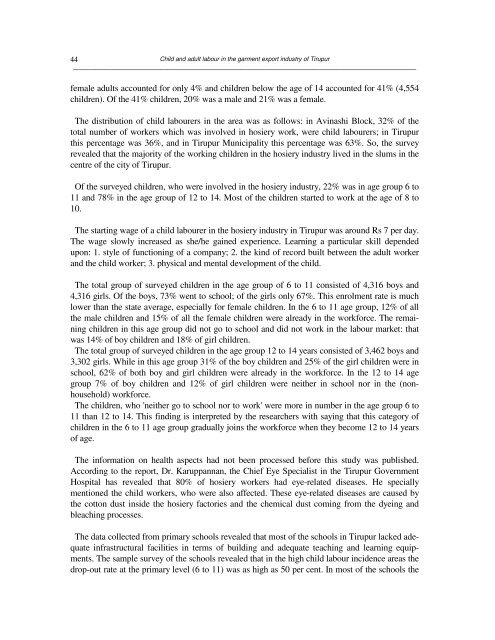Create successful ePaper yourself
Turn your PDF publications into a flip-book with our unique Google optimized e-Paper software.
44<br />
<strong>Child</strong> <strong>and</strong> <strong>adult</strong> <strong>labour</strong> <strong>in</strong> <strong>the</strong> <strong>garment</strong> <strong>export</strong> <strong>in</strong>dustry <strong>of</strong> Tirupur<br />
──────────────────────────────────────────────────────────────────────────────────────────────<br />
female <strong>adult</strong>s accounted for only 4% <strong>and</strong> children below <strong>the</strong> age <strong>of</strong> 14 accounted for 41% (4,554<br />
children). Of <strong>the</strong> 41% children, 20% was a male <strong>and</strong> 21% was a female.<br />
The distribution <strong>of</strong> child <strong>labour</strong>ers <strong>in</strong> <strong>the</strong> area was as follows: <strong>in</strong> Av<strong>in</strong>ashi Block, 32% <strong>of</strong> <strong>the</strong><br />
total number <strong>of</strong> workers which was <strong>in</strong>volved <strong>in</strong> hosiery work, were child <strong>labour</strong>ers; <strong>in</strong> Tirupur<br />
this percentage was 36%, <strong>and</strong> <strong>in</strong> Tirupur Municipality this percentage was 63%. So, <strong>the</strong> survey<br />
revealed that <strong>the</strong> majority <strong>of</strong> <strong>the</strong> work<strong>in</strong>g children <strong>in</strong> <strong>the</strong> hosiery <strong>in</strong>dustry lived <strong>in</strong> <strong>the</strong> slums <strong>in</strong> <strong>the</strong><br />
centre <strong>of</strong> <strong>the</strong> city <strong>of</strong> Tirupur.<br />
Of <strong>the</strong> surveyed children, who were <strong>in</strong>volved <strong>in</strong> <strong>the</strong> hosiery <strong>in</strong>dustry, 22% was <strong>in</strong> age group 6 to<br />
11 <strong>and</strong> 78% <strong>in</strong> <strong>the</strong> age group <strong>of</strong> 12 to 14. Most <strong>of</strong> <strong>the</strong> children started to work at <strong>the</strong> age <strong>of</strong> 8 to<br />
10.<br />
The start<strong>in</strong>g wage <strong>of</strong> a child <strong>labour</strong>er <strong>in</strong> <strong>the</strong> hosiery <strong>in</strong>dustry <strong>in</strong> Tirupur was around Rs 7 per day.<br />
The wage slowly <strong>in</strong>creased as she/he ga<strong>in</strong>ed experience. Learn<strong>in</strong>g a particular skill depended<br />
upon: 1. style <strong>of</strong> function<strong>in</strong>g <strong>of</strong> a company; 2. <strong>the</strong> k<strong>in</strong>d <strong>of</strong> record built between <strong>the</strong> <strong>adult</strong> worker<br />
<strong>and</strong> <strong>the</strong> child worker; 3. physical <strong>and</strong> mental development <strong>of</strong> <strong>the</strong> child.<br />
The total group <strong>of</strong> surveyed children <strong>in</strong> <strong>the</strong> age group <strong>of</strong> 6 to 11 consisted <strong>of</strong> 4,316 boys <strong>and</strong><br />
4,316 girls. Of <strong>the</strong> boys, 73% went to school; <strong>of</strong> <strong>the</strong> girls only 67%. This enrolment rate is much<br />
lower than <strong>the</strong> state average, especially for female children. In <strong>the</strong> 6 to 11 age group, 12% <strong>of</strong> all<br />
<strong>the</strong> male children <strong>and</strong> 15% <strong>of</strong> all <strong>the</strong> female children were already <strong>in</strong> <strong>the</strong> workforce. The rema<strong>in</strong><strong>in</strong>g<br />
children <strong>in</strong> this age group did not go to school <strong>and</strong> did not work <strong>in</strong> <strong>the</strong> <strong>labour</strong> market: that<br />
was 14% <strong>of</strong> boy children <strong>and</strong> 18% <strong>of</strong> girl children.<br />
The total group <strong>of</strong> surveyed children <strong>in</strong> <strong>the</strong> age group 12 to 14 years consisted <strong>of</strong> 3,462 boys <strong>and</strong><br />
3,302 girls. While <strong>in</strong> this age group 31% <strong>of</strong> <strong>the</strong> boy children <strong>and</strong> 25% <strong>of</strong> <strong>the</strong> girl children were <strong>in</strong><br />
school, 62% <strong>of</strong> both boy <strong>and</strong> girl children were already <strong>in</strong> <strong>the</strong> workforce. In <strong>the</strong> 12 to 14 age<br />
group 7% <strong>of</strong> boy children <strong>and</strong> 12% <strong>of</strong> girl children were nei<strong>the</strong>r <strong>in</strong> school nor <strong>in</strong> <strong>the</strong> (nonhousehold)<br />
workforce.<br />
The children, who 'nei<strong>the</strong>r go to school nor to work' were more <strong>in</strong> number <strong>in</strong> <strong>the</strong> age group 6 to<br />
11 than 12 to 14. This f<strong>in</strong>d<strong>in</strong>g is <strong>in</strong>terpreted by <strong>the</strong> researchers with say<strong>in</strong>g that this category <strong>of</strong><br />
children <strong>in</strong> <strong>the</strong> 6 to 11 age group gradually jo<strong>in</strong>s <strong>the</strong> workforce when <strong>the</strong>y become 12 to 14 years<br />
<strong>of</strong> age.<br />
The <strong>in</strong>formation on health aspects had not been processed before this study was published.<br />
Accord<strong>in</strong>g to <strong>the</strong> report, Dr. Karuppannan, <strong>the</strong> Chief Eye Specialist <strong>in</strong> <strong>the</strong> Tirupur Government<br />
Hospital has revealed that 80% <strong>of</strong> hosiery workers had eye-related diseases. He specially<br />
mentioned <strong>the</strong> child workers, who were also affected. These eye-related diseases are caused by<br />
<strong>the</strong> cotton dust <strong>in</strong>side <strong>the</strong> hosiery factories <strong>and</strong> <strong>the</strong> chemical dust com<strong>in</strong>g from <strong>the</strong> dye<strong>in</strong>g <strong>and</strong><br />
bleach<strong>in</strong>g processes.<br />
The data collected from primary schools revealed that most <strong>of</strong> <strong>the</strong> schools <strong>in</strong> Tirupur lacked adequate<br />
<strong>in</strong>frastructural facilities <strong>in</strong> terms <strong>of</strong> build<strong>in</strong>g <strong>and</strong> adequate teach<strong>in</strong>g <strong>and</strong> learn<strong>in</strong>g equipments.<br />
The sample survey <strong>of</strong> <strong>the</strong> schools revealed that <strong>in</strong> <strong>the</strong> high child <strong>labour</strong> <strong>in</strong>cidence areas <strong>the</strong><br />
drop-out rate at <strong>the</strong> primary level (6 to 11) was as high as 50 per cent. In most <strong>of</strong> <strong>the</strong> schools <strong>the</strong>


















